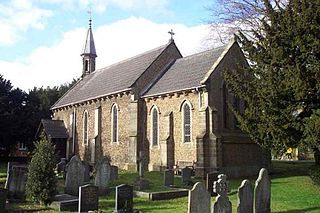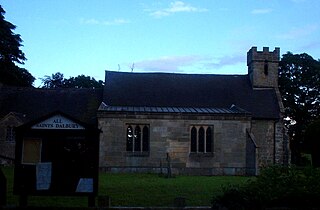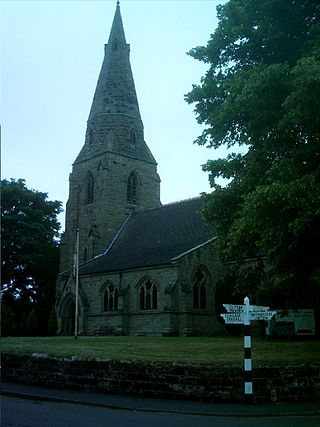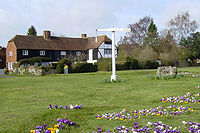
Weston is a village in the civil parish of Welford in the English county of Berkshire.
Leybourne is a small village and civil parish in Kent, England situated off Junction 4 of the M20 Motorway. Leybourne is adjacent to New Hythe, Larkfield and West Malling. As of 2020 Leybourne Parish had a population of 4,372.

Stonton Wyville is a small village and civil parish in the Harborough district of Leicestershire, England. According to the 2001 census the parish had a population of 21. The population at the 2011 census remained fewer than 100 and was included in the civil parish of Glooston. The village is about eleven miles (17 km) south east of Leicester. Nearby places include Kibworth Harcourt, Tur Langton, Church Langton, and Shangton.

Alkmonton is a village and civil parish in the Derbyshire Dales district of Derbyshire, England, roughly between Uttoxeter and Derby. The parish had a population of 75 at the 2001 census and it remained less than 100 in 2011. Details are included in the civil parish of Cubley, Derbyshire.

Quinton is a civil parish in the Stratford-on-Avon district of Warwickshire, England, about six miles south of Stratford-upon-Avon. According to the 2001 Census it had a population of 1,503, increasing to 1,968 at the 2011 Census. The parish contains Upper Quinton and Lower Quinton. It lies on the Heart of England Way.

Stebbing is a small village in the Uttlesford district of northern Essex, England. The village is situated north of the ancient Roman road Stane Street. It is 6 miles (9.7 km) from the nearest railway station (Braintree), and 8 mi (13 km) from nearest airport. The village has a pub and a bowling green and had a population of 1,300 in 2011 census.
Ruckinge is a village and civil parish in south Kent centred 5.5 miles (8.9 km) south of Ashford on the B2067 Hamstreet to Hythe road, with two settled neighbourhoods. It is, broadly defined, a narrow, fairly large rural parish of land which is about one quarter woodland.
Newton Solney is a small village and civil parish in South Derbyshire, England, located about two miles (3 km) from the East Staffordshire border, near to Burton upon Trent. The population of the civil parish as of the 2011 census was 659. Its nearest neighbour is Repton, situated about two miles (3 km) to the northeast.

Twyford and Stenson is a civil parish in the South Derbyshire district of Derbyshire, England. Located south of Derby on the Trent and Mersey Canal, it consists of two villages, Stenson and its smaller neighbour Twyford.

Elvaston is a small village and civil parish in Derbyshire, England. The parish also includes two hamlets, Ambaston and Thulston, and a modern housing estate, Boulton Moor. The population of the civil parish taken at the 2011 Census was 1,801.

Foremark is a hamlet and civil parish in the South Derbyshire district of Derbyshire, England. It contains Foremarke Hall, a medieval manor house which now houses Repton Preparatory School; and part of Foremark Reservoir.
West Peckham is a village and civil parish in the borough of Tonbridge and Malling in Kent, England. The River Bourne flows through the extreme west of the parish, and formerly powered a paper mill and corn mill. The Wateringbury Stream rises in the parish. Oxon Hoath is the former manor house of West Peckham.

Layham is a small village and a civil parish in southern Suffolk, England, situated between the town of Hadleigh and the neighbouring village of Raydon.

Fifield is a village and civil parish about 4 miles (6.4 km) north of Burford in Oxfordshire. The western boundary of the parish forms part of the county boundary with Gloucestershire. The 2011 Census recorded the parish's population as 240.

Dalbury Lees is a parish in south Derbyshire. The population of the civil parish as taken at the 2011 Census was 306. It is about six miles (10 km) from both Burton-on-Trent and Derby and just under four miles (6 km) from Egginton. The parish contains the villages of Dalbury and Lees which are just under 2 miles (3.2 km) apart from one another. Dalbury Lees has been known as Dalbury and as Dalbury with Lees, but Dalbury Lees is the preferred term

Sutton-on-the-Hill is a parish in south Derbyshire eight miles (13 km) west of Derby. The population of the civil parish taken at the 2011 Census was 123. The village is widely spread out and contains both a church and a chapel. It was described as "a parish, with two townships and a hamlet" in the 1870s. Now it has no shop or post office and limited public transport links. Sutton on the Hill is primarily an agricultural area with former dairy farms at either end of the village, along with the Sutton Estate Farm. The village school has been converted into a village hall and has a nursery school for the local villages.

Cubley is a parish of two closely linked villages six miles (10 km) south of Ashbourne in Derbyshire. Great Cubley and Little Cubley are known collectively as Cubley. The parish church of St Andrew is roughly equidistant from the two, but is formally in Great Cubley. The church is Grade I listed. The population of the civil parish taken at the 2011 Census was 232.

Lullington is a village and civil parish in the district of South Derbyshire, England. The population of the civil parish at the 2011 Census was 121. It has an All Saints' Church, a village hall and a pub, the Colvile Arms. In 1850, it had a school that was designed to take fifty children.

Smisby is an ancient manor, civil parish and small village in South Derbyshire, England. It is 4 miles (6.4 km) from Melbourne and near the Leicestershire border and the town of Ashby-de-la-Zouch. The village including the outlying farms and houses has a population just over 200 that occupies some 110 properties. The population at the 2011 Census had increased to 260.

Wichling is a village and civil parish within the local government district of Maidstone, in England. The parish lies approximately 10 miles (16 km) to the east of Maidstone. It lies near the top of the ridge of the North Downs and consists mainly of isolated farms and houses: the population is therefore small in number.




















